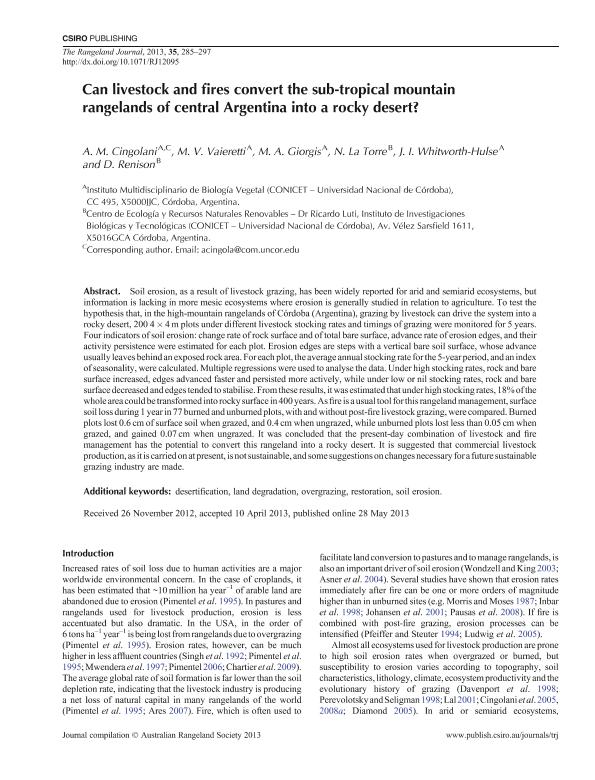Mostrar el registro sencillo del ítem
dc.contributor.author
Cingolani, Ana María

dc.contributor.author
Vaieretti, Maria Victoria

dc.contributor.author
Giorgis, Melisa Adriana

dc.contributor.author
La Torre, N.
dc.contributor.author
Whitworth Hulse, Juan Ignacio

dc.contributor.author
Renison, Daniel

dc.date.available
2017-01-04T17:42:11Z
dc.date.issued
2013-03
dc.identifier.citation
Cingolani, Ana María; Vaieretti, Maria Victoria; Giorgis, Melisa Adriana; La Torre, N.; Whitworth Hulse, Juan Ignacio; et al.; Can livestock and fires convert the sub-tropical mountain rangelands of central Argentina into a rocky desert?; Australian Rangeland Soc; Rangeland Journal; 35; 3; 3-2013; 285-297
dc.identifier.issn
1036-9872
dc.identifier.uri
http://hdl.handle.net/11336/10815
dc.description.abstract
Soil erosion, as a result of livestock grazing, has been widely reported for arid and semi-arid ecosystems, but information is lacking in more mesic ecosystems where erosion is generally studied in relation to agriculture. To test the hypothesis that, in the high-mountain rangelands of Córdoba (Argentina), grazing by livestock can drive the system into a rocky desert, two-hundred 4 x 4 m plots under different livestock stocking rates and timings of grazing were monitored for five years. Four indicators of soil erosion: change rate of rock surface and of total bare surface, advance rate of erosion edges, and their activity persistence were estimated for each plot. Erosion edges are steps with a vertical bare soil surface, whose advance usually leaves behind an exposed rock area. For each plot, the average annual stocking rate for the five-year period, and an index of seasonality, were calculated. Multiple regressions were used to analyze the data. Under high stocking rates, rock and bare surface increased, edges advanced faster and persisted more actively, while under low or nil stocking rates, rock and bare surface decreased and edges tended to stabilize. From these results, it was estimated that under high stocking rates, 18 % of the whole area could be transformed into rocky surface in 400 years. As fire is a usual tool for this rangeland management, surface soil loss during one year in 77 burned and unburned plots, with and without post-fire livestock grazing, were compared. Burned plots lost 0.6 cm of surface soil when grazed, and 0.4 cm when ungrazed, while unburned plots lost less than 0.05 cm when grazed, and gained 0.07 cm when ungrazed. It was concluded that the present-day combination of livestock and fire management has the potential to convert this rangeland into a rocky desert. It is suggested that commercial livestock production, as it is carried-on at present, is not sustainable, and some suggestions on changes necessary for a future sustainable grazing industry are made.
dc.format
application/pdf
dc.language.iso
eng
dc.publisher
Australian Rangeland Soc

dc.rights
info:eu-repo/semantics/openAccess
dc.rights.uri
https://creativecommons.org/licenses/by-nc-sa/2.5/ar/
dc.subject
Soil Erosion
dc.subject
Livestock
dc.subject
Desertification
dc.subject
Land Degradation
dc.subject.classification
Ecología

dc.subject.classification
Ciencias Biológicas

dc.subject.classification
CIENCIAS NATURALES Y EXACTAS

dc.title
Can livestock and fires convert the sub-tropical mountain rangelands of central Argentina into a rocky desert?
dc.type
info:eu-repo/semantics/article
dc.type
info:ar-repo/semantics/artículo
dc.type
info:eu-repo/semantics/publishedVersion
dc.date.updated
2016-12-12T14:17:13Z
dc.journal.volume
35
dc.journal.number
3
dc.journal.pagination
285-297
dc.journal.pais
Australia

dc.description.fil
Fil: Cingolani, Ana María. Consejo Nacional de Investigaciones Científicas y Técnicas. Centro Científico Tecnológico Córdoba. Instituto Multidisciplinario de Biología Vegetal (p); Argentina. Universidad Nacional de Córdoba; Argentina
dc.description.fil
Fil: Vaieretti, Maria Victoria. Consejo Nacional de Investigaciones Científicas y Técnicas. Centro Científico Tecnológico Córdoba. Instituto Multidisciplinario de Biología Vegetal (p); Argentina. Universidad Nacional de Córdoba; Argentina
dc.description.fil
Fil: Giorgis, Melisa Adriana. Consejo Nacional de Investigaciones Científicas y Técnicas. Centro Científico Tecnológico Córdoba. Instituto Multidisciplinario de Biología Vegetal (p); Argentina. Universidad Nacional de Córdoba; Argentina
dc.description.fil
Fil: La Torre, N.. Consejo Nacional de Investigaciones Científicas y Técnicas. Centro Científico Tecnológico Córdoba. Instituto de Investigaciones Biológicas y Tecnológicas; Argentina. Universidad Nacional de Córdoba; Argentina
dc.description.fil
Fil: Whitworth Hulse, Juan Ignacio. Consejo Nacional de Investigaciones Científicas y Técnicas. Centro Científico Tecnológico Córdoba. Instituto Multidisciplinario de Biología Vegetal (p); Argentina. Universidad Nacional de Córdoba; Argentina
dc.description.fil
Fil: Renison, Daniel. Consejo Nacional de Investigaciones Científicas y Técnicas. Centro Científico Tecnológico Córdoba. Instituto de Investigaciones Biológicas y Tecnológicas; Argentina. Universidad Nacional de Córdoba; Argentina
dc.journal.title
Rangeland Journal

dc.relation.alternativeid
info:eu-repo/semantics/altIdentifier/url/http://www.publish.csiro.au/rj/RJ12095
dc.relation.alternativeid
info:eu-repo/semantics/altIdentifier/doi/http://dx.doi.org/10.1071/RJ12095
Archivos asociados
